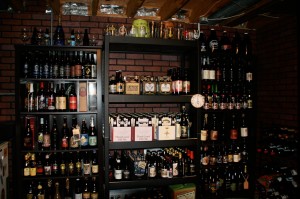“All About The Beer”
with Mitch Biggar

If you’re interested in starting your own beer cellar it’s actually pretty easy. First, you’ll need to maintain enough patience and will-power to not drink them too early. This, beyond anything else, is the public enemy number one to your attempts. There’s nothing worse than thinking about that special beer, just sitting there, as it whispers its sweet song to the pleasure portion of the brain, “Drink me”. .
Next, you’ll need to buy at least two of each beer. One of the beers you’ll want to drink immediately so you’ll have a comparison in which to judge the aged one – taking some notes if you want. The other beer should be cellared for at least a year.
Now there’s a lot of debate surrounding storing a beer upright vs. laying it down like a wine, specifically towards corked bottles. Some “experts” have faith in the old school wine way, that a corked beer should be kept on its side in order to keep the cork from drying out, while others believe that it doesn’t really matter. In my opinion, ALL beer should be stored upright. Here’s why we believe so, along with some other interesting facts about storage and cork:
- Cork cells are impregnated with a waxy material, called suberin, that is almost impermeable to water or gases. Cork is also buoyant due to the presence of trapped air in the cavities of the waterproof dead cells. When cut these cells act as suction-cups and become adhesive, thus making them ideal bottle stoppers.
- Natural cork is sometimes prone to drying out, however we’ve never had any problems — even with beers aged 10+ years upright. Today’s modern plastic/synthetic, screw cap, agglomerated, technical and capsulated corks are a lot less prone to shrinkage, to the point where it’s not even worth worrying about. If a beer has been both corked and capped or corked then waxed, cork shrinkage is definitely not a major concern.
- The inside of the bottle already contains its own humidity level, and as a result will not dry out the portion of the cork inside the bottle if stored properly. So the idea of laying a beer down to ensure that the liquid touches the cork to prevent drying is a moot point — remember “almost impermeable to water”, the cork is not going to act like a sponge. It’s the cork exposed to the open air that should be of concern, however an ample amount of humidity is all that is required to stop any exposed cork from drying out during long-term storage.
- Cork problems are usually a sign of a bad cork or a cork that has passed its lifespan, not necessarily a sign of poor storage. Agglomerated corks last for about 1-3 years before beginning to disintegrate. Plastic corks eventually lose their elasticity, too. We suggest contacting the brewery to find out what type of cork they used, and its expected lifespan.
- Long storage of a beer on its side can create a yeast ring (or water-mark) inside the bottle, which will not settle. Storing a beer upright will ensure that the yeast compacts to the bottom of the bottle.
- The upright storage method decreases the amount of exposed beer thus slowing oxidation of the beer.
So now you have a better understanding on how to store a beer. Next, where to store? First, beer should never come into contact with heat or light. Both will wreak havoc on your delicate stash of brews.
Store your beer in a cool area, away from direct light, sources of heat and in a constant temperature environment. Speaking of which, temperature is very important, and a major factor in the storing and serving aspects of beer. It also can become a real balancing act. Beer benefits from cool constant temperatures; usually around 50-55 degrees F is ideal for most beers, and most beer collectors. Higher temperatures and you’ll risk shortening the lifespan of your beer, lower and you’ll induce chill haze (cloudy). Note on refrigerators: Long-term use is not recommended. Refrigerators are designed to keep food dry, so dehydration of cork can become an issue (laid-down or upright). Corked beers that you wish to age long-term should be kept in a cellar, where moderate humidity levels might be more appropriate. .
Cool. Now that you have an idea as to what to cellar and how, what can you expect a year or more down the road when you’ve patiently waiting to crack open your aging beers? The answer = who knows? There are way too many variables that come to play, on top of the variations within the different styles. Some beers age very well, others don’t. Some beers need only a year, while others can age for 25+ years. And, many breweries have no idea what their beer will taste like years down the road, while others can make pretty good predictions. It’s all part of the fun. .
Some final advice: if you cellared your beer too cold, then serve it immediately you’ll get less carbonation, less aroma and less flavour. You’ll also risk numbing your palate. Use the store temp = serve temp rule and you’ll be fine.
Beer related questions? Email mitch@railcarbrewing.com
